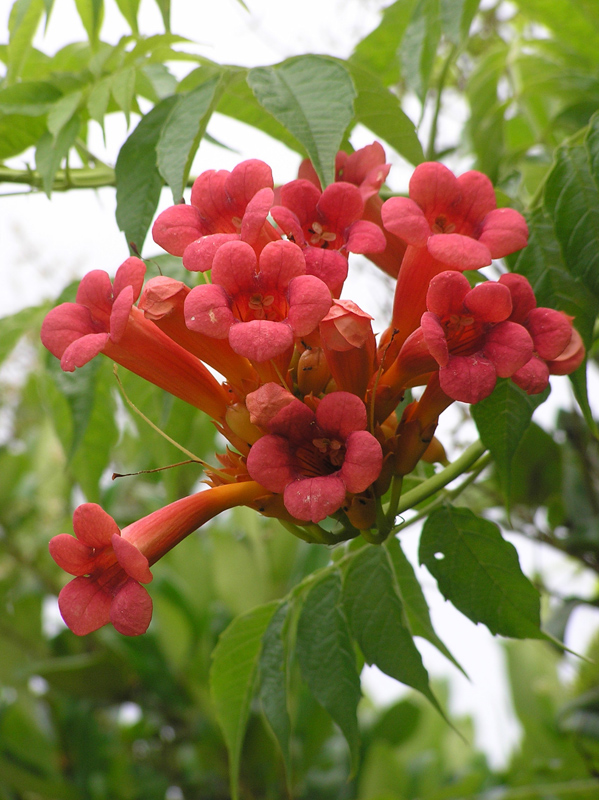Trumpet-creeper: Just one of our great native vines

By Ken Moore
Flora Columnist
Our roadsides are so filled with flowering wild plants that it frustrates me to focus on just one or two for description in The Citizen.
Right now, I have to celebrate the Trumpet-creeper. Some folks call it Trumpet Vine or Cow-itch Vine. There are likely other names associated with this common native weedy vine, of which the bright orange tubular flowers are guaranteed to attract nearby hummingbirds. Keep an eye out to find occasional peach- and yellow-colored variations. The flowers seem to hang singly or in clusters in the air at the tips of long stems reaching down from varying heights, be it low fence posts or abandoned barn chimneys.
One of my favorite specimens is a vine on a utility pole on Weaver Dairy Road between Carol Woods and Timberline Shopping Center.
That vine-covered pole looks like a mop-headed giant having a bad-hair day when it’s covered with those orange flowers reaching out all around. Equally dramatic is the Trumpet-creeper-covered Privet hedge separating Auto Logic and Akai Hana restaurant in Carrboro. I am fortunate to have one that sprouted at the base of the tall cedar post on which my mailbox is mounted. It’s now reached the top, and is sending orange flowers out from way up high as well as having some lower-reaching lengths to tickle the postman at the letter box.
That vine-covered arbor along the south side of Coker Arboretum is now colorful, with red, orange and blue flowers of North Carolina native vines worthy of cultivation in our home landscapes. They are all easy to grow, will put up with our typical droughts, and the tubular flowers of the red Coral honeysuckle (Lonicera sempervirens), orange-red flowers of Cross-vine (Bignonia capreolata) and orange flowers of Trumpet-creeper (Campsis radicans) all attract hummingbirds. The blue-flowered clusters of the re-blooming native wisteria (Wisteria floribunda) most likely will also have hummingbirds visiting, because those flying nectar-lovers never learned to visit only tubular red and orange flowers.
If you aren’t lucky enough to have these native vines occurring naturally for you, the local nurseries carry one or more of them, including named cultivars. If they don’t have them, request them. They are too satisfactory not to have one or more growing in your own garden.
Fire station Holly tree update
The people assembled in the Town Hall board room last Thursday for a second public discussion of the Homestead Road Carrboro Fire Station site seemed genuinely pleased to have been part of a real planning and design work session. Much serious discussion and energetic moving around of little paper models of building components engaged all participants in creatively thinking together.
In addition to town staff, fire chief Travis Crabtree and some of his crew, Mayor Mark Chilton and board member Randee Haven-O’Donnell were in attendance during the entire afternoon. Those present appreciated that among the participants were some with design expertise. Several thoughtful scenarios that met the program needs and saved several of the big trees on the site were developed.
We were pleased to learn at the beginning of the session that new site considerations indicate that the big 200-year-old Holly on the edge of the site can be avoided during construction of the fire station. In addition, the tree was given a relatively good bill of health by an arborist with the Bartlett Tree Company, with an evaluation that the tree is worth saving.
Indications are that Ken Newell and Associates will come back with some design recommendations reflective of the many ideas developed by the individuals working together at the gathering. It is hoped that preserving some of the other big trees on the site can be included in the design to provide immediate significant shade as well as provide mature landscape features that are reflective of the character and heritage of the old farm homestead that used to be there on Homestead Road.
So a sentiment has been voiced that the 200-year-old Holly tree can be saved and perhaps some of the other half dozen or more mature specimen trees can be preserved within the design. We are appreciative that the town board and staff provided more opportunity for citizen input. We now have a responsibility to remain active to help the town ensure that whatever specimen trees are designated for preservation on the site are not destroyed or injured during the many long months of site preparation and construction.
Email Ken Moore at flora@carrborocitizen.com.


Comments are closed.